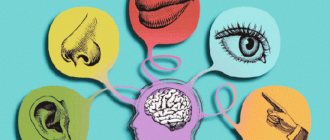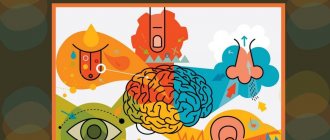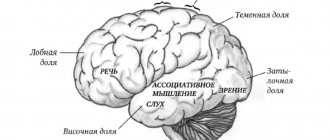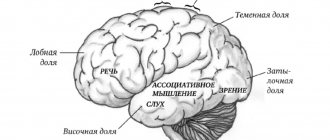Sensations, perceptions, feelings... - in scientific psychology there are a lot of concepts that are similar to each other, the difference between which is very difficult for a person far from this science to see. Nevertheless, each of these concepts has its own unique meaning, knowledge of which allows you to better understand yourself and know your nature.
In this article we will consider in detail the concept of sensations, their main types, physiological mechanisms, properties, functions and patterns. And in conclusion, we’ll tell you how to develop your senses in order to achieve success in your professional activities or simply learn to perceive the world around you more subtly, enjoying simple things.
If you want to learn not only about sensations, but also about other areas of psychological knowledge, be sure to sign up for our online Self-Knowledge program, with the help of which you will learn to better understand yourself and will definitely find a life path that will make you truly happy.
Content
- Physiological mechanism of sensations
- Types of sensations according to Sherrington
- Properties of sensations
- Sensitivity thresholds
- Sensory disorders
- Adaptation, synesthesia, sensitization
Sense organs are organs that perceive and partially process information that can come from both outside and inside. There are 5 main sense organs: eyes, nose, skin, ears, tongue.
Visual sensations
With the help of the eyes, a person receives 80-90% of information about the world around him. Visual sensations arise when light rays act on the nerve cells of the retina. Rods (130 million) are located on the periphery of the retina; they are responsible for distinguishing between black, white, and gray at any time of the day. Cones (7 million) are located in the center and are responsible for distinguishing color. The mechanism for creating visual sensations: the stimulus acts on the nerve cells of the retina of the eye, excitation occurs, which is transmitted along the pathways to the corresponding part of the brain.
Olfactory sensations
The sense of smell is one of the most ancient and important senses from an evolutionary point of view. Many animals use these sensations to navigate in space, defend themselves from attacks, communicate, choose partners, etc. Olfactory sensations are caused by particles of a substance that fall on the nasal mucosa.
Tactile sensations
Nerve fibers located in every area of the skin send signals to the brain about temperature fluctuations, touch, and pain. The skin perceives vibration, temperature, electrical, chemical, and mechanical irritations.
Auditory sensations
Auditory sensations are caused by auditory waves, i.e. air vibrations from a sound source. The human hearing range is 16-20,000 vibrations per second (16 Hz-20 kHz), higher frequencies are ultrasound, lower frequencies are infrasound. 1000 vibrations per second is normal.
Taste sensations
During taste sensations, particles of objects affect the mucous membrane of the tongue. There are 4 basic tastes: sour, bitter, sweet, salty. The tongue is conventionally divided into several zones, each of which perceives its own type of taste.
Sometimes the vestibular apparatus in the inner ear (sense of balance and sensation in space), as well as muscles, tendons, ligaments (changes in the position of individual parts and the entire body in space, determination of the mass and volume of objects, analysis of movements and their coordination) are added to this list.
Development of sensations: why and how to do it?
Sensitivity is innate and unconditionally reflexive, but it is also a potential personality trait. If you do not develop your sensory organization, you will certainly not lose the ability to see, feel, hear, etc. However, these abilities will be limited and will not reveal the full potential inherent in you by nature.
But if you learn to train your senses, you can discover a whole new world, full of color and variety, and enjoy truly beautiful things that are quite simple, but at the same time inaccessible to someone who has insufficiently developed sensitivity: for example, having fun from classical music or the subtlest notes of wine.
In addition, sensitivity to external stimuli plays a huge role in some professional fields. For example, it is simply necessary for musicians, artists, perfumers, chefs, etc. Only those people who have developed sensitivity are able to achieve non-trivial success in these areas. Therefore, if you want to have a perfect ear for music or unsurpassed artistic taste, you will need to develop your sensitivity.
There are two main ways to improve your sensations - developing the sensitivity of your analyzers and improving your ability to discriminate, i.e. the ability to clearly differentiate the various properties of objects in the surrounding world.
The development of sensations is based on the limitation of the initial generalization of excitations in the cortical sections of the analyzers through the development of special differentiations. Therefore, in order to improve your sensations, when performing any activity, you need to highlight individual elements in it and focus your attention on them, and not on the entire process as a whole.
For example, if we talk about ear for music, then to develop it you can either increase the threshold of your auditory sensitivity, or learn to distinguish in complex sound stimuli their component parts - musical tones. The optimal way would be to improve both of these components at the same time - this is how you can develop your sensations to the maximum extent.
With regular exercise, you can significantly improve your sensitivity and learn to perceive the world at a higher level. In the psychological method known as “Integrative Linguistic-Psychological Training (ILPT),” such exercises are called psychotechnics. Here are some of them :
- Make up stories by listening to noises (this could be whispering, whistling, the hissing of snakes, rustling leaves, etc.)
- Guess various multi-component scents blindfolded, associate them with your memories or fantasies, and then make sketches of the resulting associations.
- Bring your paintings to life. Describe them (preferably in a foreign language) and express the emotions you feel from them. Try to feel all the sensations that arise: perhaps you feel cold or dry, hear birds singing, smell the sea...
- Listen to musical works and imagine them in color (for example, a fragment of “The Spanish Dance” by E. Grandos, “The Swan” by C. Saint-Saëns or R. Wagner’s music for the opera “Twilight of the Gods”).
Despite the fact that all the proposed exercises have a specific focus on the development of one channel of perception, they are multifunctional and allow you to improve all types of senses at the same time.
In addition, you can use the following methods to increase the sensitivity of analyzers :
- Visual acuity is promoted by taking vitamins A, E and C (you can take them in the form of dietary supplements or add foods rich in them to your diet), as well as eye exercises.
- To improve your hearing, take magnesium, listen to different genres of music, learn to sing or play a musical instrument. Try to spend more time in silence and avoid noisy places.
- The easiest way to improve your sense of smell is through the practice of aromatherapy: inhale a few pleasant smells every day, and when you learn to distinguish them, increase the number of them.
- To learn to better distinguish tastes, reduce your salt and sugar intake, avoid processed foods, flavor enhancers, etc., because... These components negatively affect taste sensitivity. But seafood and natural spices contribute to its development.
- You can increase skin sensitivity by practicing interaction with different textures. Try to touch different surfaces and reliefs as much as possible and learn to distinguish between them with your eyes closed.
Performing these simple exercises and using the above-mentioned methods for increasing sensitivity will definitely help you make your sensations clearer and more distinct. However, before using vitamins and minerals, be sure to consult with your doctor, because sometimes even the most beneficial substances may not be suitable specifically for your body.
We wish you success in self-knowledge and self-development and hope that our article will be useful to you!
We also recommend reading:
- Storytelling
- Mental processes: types and brief description
- Two important laws of memory
- Spheres of personality
- Wundt's method of studying psychology
- Philosophical foundations of the linguistic concept of Wilhelm von Humboldt
- Feelings, emotions and sensations: the first step to profiling
- Machism: Ernst Mach's contribution to the development of the philosophy of positivism
- Sensation and perception
- Psychic reflection
- Cognitive sphere of personality
Key words: 1Psychoregulation, 1Self-knowledge
Physiological mechanism of sensations
The process of the emergence of sensations can be represented as follows. An irritant (music) with certain characteristics affects a certain sense organ (ears), which perceives information and transmits it along conductive pathways to the brain, where this information is processed, and we begin to hear music. This is how the surrounding world is reflected.
Charles Sherrington, an English physiologist, Nobel Prize laureate in physiology or medicine, proposed a classification of sensations according to the nature of reflection and location of receptors.
Your psychologist. The work of a psychologist at school.
What are sensations?Sensations are the initial source of all our knowledge about the world. With the help of sensations, we cognize the size, shape, color, density, temperature, smell, taste of objects and phenomena around us, catch various sounds, comprehend movement and space, etc. It is sensations that provide material for complex mental processes - perception, thinking, imagination .
If a person were deprived of all sensations, he would not be able to cognize the world around him in any way and understand what is happening around him. Thus, people who are blind from birth are not able to imagine what red, green or any other color is; people who are deaf from birth are not able to imagine what the sound of a human voice, birdsong, musical melodies, the sounds of passing cars and flying airplanes, etc. are.
A prerequisite for the occurrence of sensation is the direct impact of an object or phenomenon on our senses. Objects and phenomena of reality that affect the senses are called stimuli. The process of their influence on the sense organs is called irritation.
Already the ancient Greeks distinguished five senses and their corresponding sensations: visual, auditory, tactile, olfactory and gustatory. Modern science has significantly expanded our understanding of the types of human sensations.
A sense organ is an anatomical and physiological apparatus located on the periphery of the body or in the internal organs; specialized to receive exposure to certain stimuli from the external and internal environment. Each such device connects the brain with the outside world and ensures that various information enters the brain. I.P. Pavlov suggested calling them analyzers.
Any analyzer consists of three sections: a sensory organ - a receptor (from the Latin word “receptor” - receiving), which perceives the stimulus acting on it; the conductive part and the nerve centers of the cerebral cortex, where the processing of nerve impulses occurs. All sections of the analyzer work as a single whole. The sensation will not occur if any part of the analyzer is damaged. Thus, visual sensations cease when the eyes are damaged, when the optic nerves are damaged, and when the corresponding areas of the cerebral cortex are destroyed.
The surrounding reality, influencing our sense organs (eye, ear, endings of sensory nerves in the skin, etc.), causes sensations. Sensations appear when excitation in a sensory organ caused by some stimulus spreads along centripetal paths to the corresponding areas of the cerebral cortex and is subjected to the finest analysis there.
The brain receives information both from the outside world and from the body itself. Therefore, analyzers are external and internal. External analyzers have receptors located on the surface of the body - the eye, ear, etc. Internal analyzers have receptors located in internal organs and tissues. The motor analyzer occupies a peculiar position.
The analyzer is a complex nervous mechanism that performs a subtle analysis of the surrounding world, that is, it identifies its individual elements and properties. Each analyzer is adapted to highlight certain properties of objects and phenomena: the eye reacts to light stimuli, the ear to auditory stimuli, etc.
The main part of each sense organ is the receptors, the endings of the sensory nerve. These are sensory organs that respond to certain stimuli: the eye, ear, tongue, nose, skin, and special receptor nerve endings embedded in the muscles, tissues and internal organs of the body. Sense organs such as the eye and ear combine tens of thousands of receptor endings. The impact of a stimulus on the receptor leads to the generation of a nerve impulse, which is transmitted along the sensory nerve to certain areas of the cerebral cortex.
Sensation is a reflection of the individual properties of objects and phenomena during their direct impact on the senses.
Currently, there are about two dozen different analyzer systems that reflect the effects of the external and internal environment on the body. Different types of sensations arise as a result of the influence of different stimuli on different analyzers. We receive sensations using the senses. Each of them gives us its own special sensations - visual, auditory, olfactory, gustatory, etc.
Types of sensations.
All sensations can be divided into two groups: 1) Sensations that reflect the properties of things or phenomena located outside of us. The organs of these sensations are located on the surface of the body or close to it. 2) Sensations that reflect the movements of individual parts of our body and the state of our internal organs. The organs of these sensations are located deep in the tissues (for example, muscles) or on the surface of internal organs (for example, in the walls of the stomach, respiratory tract).
The first group includes visual, auditory, olfactory, gustatory and skin sensations.
1. Visual sensations are sensations of light and color. Everything we see has some color. Only a completely transparent object that we cannot see can be colorless. Colors are achromatic (white and black and shades of gray in between) and chromatic (various shades of red, yellow, green, blue).
Visual sensations arise as a result of the influence of light rays (electromagnetic waves) on the sensitive part of our eye. The light-sensitive organ of the eye is the retina, which contains two types of cells - rods and cones, so named for their external shape. There are a lot of such cells in the retina - about 130 rods and 7 million cones.
In daylight, only cones are active (such light is too bright for rods). As a result, we see colors, i.e. there is a feeling of chromatic colors - all the colors of the spectrum. In low light (at dusk), the cones stop working (there is not enough light for them), and vision is carried out only by the rod apparatus - a person sees mainly gray colors (all transitions from white to black, i.e. achromatic colors).
There is a disease in which the functioning of the rods is disrupted and a person sees very poorly or sees nothing at dusk and at night, but during the day his vision remains relatively normal. This disease is called “night blindness”, since chickens and pigeons do not have rods and see almost nothing at dusk. Owls and bats, on the contrary, have only rods in their retinas - during the day these animals are almost blind.
Color has different effects on a person’s well-being and performance, and on the success of educational activities. Psychologists note that the most acceptable color for painting the walls of classrooms is orange-yellow, which creates a cheerful, upbeat mood, and green, which creates an even, calm mood. Red color excites, dark blue depresses, and both tire the eyes. In some cases, people experience disturbances in normal color perception. The reasons for this may be heredity, diseases and eye injury. The most common is red-green blindness, called color blindness (named after the English scientist D. Dalton, who first described this phenomenon). Colorblind people do not distinguish between red and green, and do not understand why people denote color in two words. Such a feature of vision as color blindness should be taken into account when choosing a profession. Colorblind people cannot be drivers, pilots, painters, fashion designers, etc. A complete lack of sensitivity to chromatic colors is very rare.
The less light, the worse a person sees. Therefore, you should not read in poor lighting, at twilight, so as not to cause unnecessary strain on the eyes, which can be harmful to vision and contribute to the development of myopia, especially in children and schoolchildren.
Auditory sensations arise through the organ of hearing. There are three types of auditory sensations: speech, music and noise. In these types of sensations, the sound analyzer identifies four qualities: sound strength (loud-weak), height (high-low), timbre (the originality of the voice or musical instrument), sound duration (playing time), as well as tempo-rhythmic features of sequentially perceived sounds. .
2. Auditory sensations. They arise with the help of the organ of hearing. There are three types of auditory sensations: speech, music and noise. In these types of sensations, the sound analyzer identifies four qualities: sound strength (loud-weak), height (high-low), timbre (the originality of the voice or musical instrument), sound duration (playing time), as well as tempo-rhythmic features of sequentially perceived sounds. .
Hearing for speech sounds is called phonemic hearing. It is formed depending on the speech environment in which the child is raised. Mastering a foreign language involves the development of a new system of phonemic hearing. A child’s developed phonemic hearing significantly influences the accuracy of written speech, especially in elementary school. A child’s musical ear is nurtured and formed, just like speech hearing. Here, the early introduction of the child to the musical culture of mankind is of great importance.
Noises can evoke a certain emotional mood in a person (the sound of rain, the rustling of leaves, the howling of the wind), sometimes they serve as a signal of approaching danger (the hiss of a snake, the menacing barking of a dog, the roar of a moving train) or joy (the patter of a child’s feet, the steps of an approaching loved one, the thunder of fireworks ). In school practice, one often encounters the negative influence of noise: it tires the human nervous system. Vibration sensations reflect vibrations of the elastic medium. A person gets such sensations, for example, when he touches the lid of a sounding piano with his hand. Vibration sensations usually do not play an important role for humans and are very poorly developed. However, they reach a very high level of development in many deaf people, for whom they partially replace missing hearing.
3. Olfactory sensations. The ability to smell is called the sense of smell. The olfactory organs are special sensitive cells that are located deep in the nasal cavity. Individual particles of various substances enter the nose along with the air that we inhale. This is how we get olfactory sensations. In modern man, the olfactory sensations play a relatively minor role. But blind-deaf people use their sense of smell, just as sighted people use their vision and hearing: they identify familiar places by smell, recognize familiar people, receive signals of danger, etc.
A person’s olfactory sensitivity is closely related to taste and helps to recognize the quality of food. Olfactory sensations warn a person about a dangerous air environment for the body (smell of gas, burning). The incense of objects has a great influence on a person’s emotional state. The existence of the perfume industry is entirely due to the aesthetic need of people for pleasant smells.
Olfactory sensations are very significant for a person in cases where they are associated with knowledge. Only by knowing the characteristics of the odors of certain substances can a person navigate them.
4. Taste sensations. They arise with the help of the taste organs - taste buds located on the surface of the tongue, pharynx and palate. There are four types of basic taste sensations: sweet, bitter, sour, salty. The variety of taste depends on the nature of the combinations of these sensations: bitter-salty, sweet-sour, etc. A small number of qualities of taste sensations does not mean, however, that taste sensations are limited. Within the limits of salty, sour, sweet, bitter, a whole series of shades arise, each of which gives the taste sensations a new uniqueness.
A person’s sense of taste is highly dependent on the feeling of hunger; tasteless food seems tastier in a state of hunger. The sense of taste is very dependent on the sense of smell. With a severe runny nose, any dish, even your favorite, seems tasteless.
The tip of the tongue tastes sweets best. The edges of the tongue are sensitive to sour, and its base is sensitive to bitter.
5. Skin sensations - tactile (sensations of touch) and temperature (sensations of heat or cold). There are different types of nerve endings on the surface of the skin, each of which gives the sensation of touch, movement, or warmth. The sensitivity of different areas of the skin to each type of irritation is different. The touch is most felt on the tip of the tongue and on the tips of the fingers; the back is less sensitive to touch. The skin of those parts of the body that are usually covered by clothing, the lower back, abdomen, and chest, is most sensitive to the effects of heat and cold. Temperature sensations have a very pronounced emotional tone. Thus, average temperatures are accompanied by a positive feeling, the nature of the emotional coloring for warmth and cold is different: cold is experienced as an invigorating feeling, warmth - as a relaxing one. High temperatures, both in the cold and warm directions, cause negative emotional experiences.
The second group includes motor sensations, sensations of balance and organic sensations.
1. Motor sensations. Their receptors are located in muscles, tendons and on articular surfaces. Motor sensations provide signals about the degree of muscle contraction and the position of our limbs, for example, how much the arm is bent at the shoulder, elbow or wrist joint. The combination of skin and motor sensations obtained by feeling objects, that is, by touching them with a moving hand, is called touch. The organ of touch is the hand with all its skin, muscle and joint receptors. The hand as an organ of touch first appears in monkeys, but reaches full development only in humans, becoming a tool for him. Skin sensations themselves signal only the fact of an object touching the body and the location of this touch. When a fly lands on our forehead, we easily notice it, but we can just as easily be misled and mistake the touch of a straw, brush, blade of grass or piece of paper for a fly. To more accurately determine the properties of an object touching the skin, its hardness, softness, roughness, smoothness, shape, outline, etc., you need to feel it. For example, the sensations of hardness and softness depend mainly on how much resistance the body provides when pressure is applied to it; therefore, it is impossible to determine the degree of hardness or softness of objects without the participation of motor sensations.
2. Feelings of balance. They reflect the position occupied by our body in space. When we first get on a two-wheeled bicycle, skate, roller skate, or water ski, the most difficult thing is to maintain balance and not fall. The sense of balance is given to us by an organ located in the inner ear. It looks like a snail shell and is called a labyrinth.
When the position of the body changes, a special fluid (lymph) vibrates in the labyrinth of the inner ear, called the vestibular apparatus. The balance organs are closely connected with other internal organs. When the balance organs are strongly overexcited, nausea and vomiting are observed (the so-called seasickness or air sickness). With regular training, the stability of the balance organs increases significantly.
The vestibular system gives signals about the movement and position of the head. If the labyrinth is damaged, a person can neither stand, nor sit, nor walk; he will fall all the time.
3. Organic feel. Their receptors are located in the walls of most internal organs: the esophagus, stomach, intestines, blood vessels, lungs, etc. Organic include the sensations that we have during hunger, thirst, satiety, nausea, internal pain, etc. So far we are completely healthy, well-fed, in general, when the internal organs work normally, we do not notice almost any organic sensations; they mainly give signals about disturbances in the functioning of internal organs. Impulses directed to the cortex from the internal organs, without being clearly conscious, underlie the general “well-being” of a person. Internal analyzers monitor, check the chemical composition and blood pressure, the condition of organs and their functioning; at the same time, they can enter into temporary communication with analyzers that bring information about external objects.
Properties of sensations.
The main properties of sensations include: quality, intensity, duration, spatial localization, threshold of sensations.
Quality is a property that characterizes the basic information displayed by a given sensation, distinguishes it from other types of sensations and varies within a given type of sensation. For example, taste sensations provide information about certain chemical characteristics of an object: sweet or sour, bitter or salty. The sense of smell also provides us with information about the chemical characteristics of an object, but of a different kind: flower smell, almond smell, hydrogen sulfide smell, etc.
It should be borne in mind that very often, when they talk about the quality of sensations, they mean the modality of sensations, since it is the modality that reflects the main quality of the corresponding sensation. The intensity of the sensation is its quantitative characteristic and depends on the strength of the current stimulus and the functional state of the receptor, which determines the degree of readiness of the receptor to perform its functions. For example, if you have a runny nose, the intensity of perceived odors may be distorted.
The duration of a sensation is a temporary characteristic of the sensation that has arisen. It is also determined by the functional state of the sensory organ, but mainly by the time of action of the stimulus and its intensity. It should be noted that sensations have a so-called patent (hidden) period. When a stimulus acts on a sense organ, the sensation does not occur immediately, but after some time. The latent period of different types of sensations is not the same. For example, for tactile sensations it is 130 ms, for pain – 370 ms, and for taste – only 50 ms.
Spatial localization of the stimulus - spatial analysis is carried out by distant receptors, it gives us information about the localization of the stimulus in space.
Threshold of sensations. The minimum value of the stimulus that causes barely noticeable sensations is the lower threshold. The maximum value of the stimulus that still causes sensations is the upper threshold. (For hearing, the min threshold is the ticking of a clock from a distance of 6 meters. For touch, the feeling of the movement of a fly’s wing when falling from a height of 1 cm).
Development of sensations.
Sensitivity, i.e. The ability to have sensations, in its elementary manifestations, is innate and is certainly a reflex. A child who has just been born already reacts to visual, sound and some other stimuli. Human hearing is formed under the influence of music and sound speech. All the wealth of human sensations is the result of development and education.
Often insufficient attention is paid to the development of sensations, especially in comparison with more complex cognitive processes - memory, thinking, imagination. But it is precisely sensations that underlie all cognitive abilities and constitute the powerful development potential of a child, which most often is not fully realized.
The structure of our senses allows us to sense much more than what we actually sense. It’s as if a complex device is not working at full capacity. Is it possible to somehow change or enhance our sensations? Of course you can.
The development of sensations occurs in connection with practical, primarily work, activity of a person and depends on the demands that life and work place on the work of the senses. A high degree of perfection is achieved, for example, by the olfactory and gustatory sensations of tasters who determine the quality of tea, wine, perfume, etc.
Painting places special demands on the sense of proportions and color shades when depicting objects. This feeling is more developed among artists than among people who do not paint. The same goes for musicians. The accuracy of determining sounds in pitch is influenced, for example, by the instrument a person plays. Playing music on the violin places special demands on the violinist's hearing. Therefore, violinists’ pitch discrimination is usually more developed than, for example, pianists’ (Kaufman’s data).
It is known that some people distinguish melodies well and repeat them easily, while others think that all melodies have the same motive. There is an opinion that an ear for music is given to a person by nature and if someone does not have it, then they will never have it. This idea is wrong. During music lessons, any person develops an ear for music. Blind people have especially acute hearing. They recognize people well not only by their voice, but also by the sound of their steps. Some blind people can distinguish trees by the noise of leaves, for example, distinguish a birch from a maple. And if they saw, then they would not have much need to pay attention to such small differences in sounds.
Methods for measuring sensations.
Methods for measuring sensations: 1) direct 2) indirect
In psychology of the late 19th – early 20th centuries. There is an idea that sense organs (receptors) passively respond to influencing stimuli and, accordingly, sensations, from this point of view, are a passive process.
The reflex theory believes that sensation is an active process - the main position of this theory is as follows - every sensation includes movement. Complex sensations are not possible without active movement; an example of a complex sensation would be feeling an object with your eyes closed.
List of used literature.
1.B. M. Teplov. “Psychology” Uchpedgiz, Moscow, 1953
2. “Psychology” by Dubrovin I.
3. Atkinson R. L., Agkinson R. S., Smith E. E. et al. “Introduction to Psychology: A Textbook for Universities” / Transl. from English under. ed. V. P. Zinchenko. - Moscow: Trivola, 1999.
4. Dmitrieva “General psychology.” (Lecture notes)
Test work by Galiullina E.A.
Mental map - sensations
Types of sensations according to Sherrington
1. Interoceptive sensations. The most ancient and elementary group of sensations. Interoceptive sensations combine signals that reach us from the internal environment of the body. They signal the state of the internal processes of the body; they arise thanks to receptors located on the walls of the stomach, heart and circulatory system and other internal organs. This type of sensation is one of the least conscious. They are associated with an emotional state.
2. Exteroceptive sensations. The largest group of sensations. They provide signals from the outside world and provide the basis for our conscious behavior. Exteroceptive sensations can be conditionally divided into 2 groups: a) contact sensations (caused by the direct impact of an object on the senses, for example, taste, touch); b) distant sensations (reflect the qualities of an object located at some distance from the sense organs, for example, hearing, vision).
3. Propreocytic sensations. They transmit information about the position of the body in space and the position of the musculoskeletal system, and provide regulation of movements. Includes the sense of balance (static sensation) and motor (kinesthetic) sensation. Receptors are located in muscles, joints, and ligaments.
Functions and role
“Our brains evolved not to react to the world around us, but to predict what will happen to us next.”
Lisa Feldman Barrett
Scientists and researchers in the field of psychology of the last century pay due attention to the role and functions of sensations, since through them we understand the world inside and around us:
- Detection: The detection element in each sense is known as a receptor, which is a cell or group of cells that are particularly sensitive to a particular type of energy or more than one form of energy.
- Conversion and transmission: Receptors convert or convert energy from one form to another. Sensory receptors convert incoming energy into electrochemical signals that the nervous system uses to communicate.
- Transmission: If this energy is strong enough, it triggers nerve impulses that convey encoded information about various characteristics of the stimulus. Impulses travel along specific nerve fibers to specific areas of the brain.
- Stimulating and regulating information processing: Both the brain and receptors process sensory information: in organisms of relative simplicity, such as frogs, receptors do most of the work. In more complex animals, such as humans, the brain has a much greater workload.
Properties of sensations
1. Modality is a qualitative characteristic of sensations. This is the basic feature of each particular sensation that can distinguish it from another sensation. For example, for auditory sensations this is pitch, timbre, volume.
2. Intensity is a quantitative characteristic of sensations. It is determined by the force with which the stimulus acts on the object.
3. Localization is a spatial characteristic of sensations. A property that indicates the localization of a stimulus in space.
4. Duration is a temporary characteristic of sensations. Indicates the time during which the stimulus was in effect.
Sensitivity thresholds
So, in order for a person to feel the effect of any stimulus, the intensity of this stimulus must have a certain value (if you are standing at a distance of a kilometer from your interlocutor, a whisper is clearly not going to help you). You can take this situation as an example.
You ask your friend, who is at a distance from you, how he is doing. But he didn’t hear you, since your voice as an irritant does not have the required intensity. You ask a little louder in hopes that he will hear you. But the interlocutor hears something vaguely reminiscent of your question. Your friend’s senses (ears) have perceived this information, but if you repeat this question a little quieter, he will no longer hear. This is called the lower absolute threshold of sensitivity, i.e. the minimum strength of the stimulus causing a barely noticeable sensation. At one point, you get tired of choosing the right sound level, because your friend can’t hear you well anyway. Instead of just walking up to him, you decide to scream at the top of your lungs so that he can definitely hear you. And you started screaming without noticing your other friend who approached you from the other side. For him, this volume level was too high, it caused pain. This is called the upper absolute threshold of sensitivity, i.e. the maximum magnitude of the stimulus at which sensations disappear or change (for example, turn into pain).
Sensation thresholds are the ability of analyzers to reflect individual properties of stimuli or subtle differences between them. Psychophysics, whose founder is considered to be Gustav Theodor Fechner, studies and measures sensation thresholds.
The absolute threshold of sensation is the minimum value of the stimulus at which sensation first occurs. Stimuli that do not reach it lie below the threshold of sensations, i.e. we do not feel them (for example, dust particles that constantly fall on the skin). The weaker the stimuli that cause sensations (i.e., the lower the absolute threshold value), the higher the ability of the sensory organs to respond to these influences.
The difference (differential) threshold is the minimum change in the intensity of the stimulus, causing a barely noticeable change in sensations.
Difference sensitivity is a relative value. Ernst Weber came to the conclusion that we do not perceive differences between objects, but the relation of the difference to the size of the objects being compared.
Concept Basics
Sensations reflect properties of the surrounding world that are important for the human body. Analyzers, which are usually called sense organs, are adapted from birth to receive and process different energies. It manifests itself in the form of an irritant - chemical, physical or mechanical. Different types of sensations reflect the actions of those stimuli that affect them.
Sensations are divided according to their qualities into olfactory, tactile, gustatory, visual and auditory. Muscles make themselves known through proprioceptive sensations; they report tissue contraction and relaxation.
The sense of balance helps determine the position of the body relative to gravitational forces.
Sensations are formed under the influence of stimuli on specific receptors. This concept refers to the reaction of the nervous system to external phenomena of the material world. Reflexes occur only when there is physical or psychological impact on a specific analyzer. Its complex includes three departments:
- peripheral;
- affective and efferent nerves;
- subcortical and cortical.
Peripheral receptors are transformers of energy coming from the surrounding world into nervous processes. Centripetal and centrifugal nerves connect the first complex to the central system. The brain end of the analyzer processes incoming nerve impulses.
The last section contains the nucleus, in which the bulk of the receptors are concentrated. It consists of scattered cells located in different parts of the cortex. The main function of the core is fine synthesis and analysis, and its elements are responsible for the gross process. But for a barely noticeable movement of the body to occur, the entire analyzer must work as a single whole.
Sensory disorders
1. Sensory hypopathy is a disorder of sensitivity in such a way that both weak and strong stimuli are felt weakly.
2. Sensory hyperpathy is a sharp increase in the intensity of sensations when exposed to weak stimuli.
3. Paresthesia is sensations without stimulus (numbness, tingling).
Hypoesthesia and paresthesia
The opposite of hyperesthesia is hypoesthesia. It is characterized by reduced sensitivity of the body to irritants. For examples, we use some types of sensations in psychology. Let's say it's severely frosty outside. A person with hypoesthesia will not feel the cold. This could lead to frostbite. That is, his exteroceptive sensations are impaired. If a person is unable to feel pain, for example, from an injection, then interoreceptive sensations are already impaired. There are many reasons for hypoesthesia. For example, anesthesia or skin diseases such as leprosy.
The next type of sensation disorder is called paresthesia. It is characterized by neurological and vascular lesions. This disorder occurs, for example, during sleep, when the whole body is compressed by one hand. Or, when sitting, you may feel numbness in some parts of your body. In such cases, people say that they rested their hand or butt. But this type of disorder can also be more serious, which requires treatment.
Adaptation, synesthesia, sensitization
Adaptation means that under the influence of the analyzers’ adaptation to the current stimuli, their sensitivity changes. It can occur in two directions: increasing and decreasing sensitivity.
Adaptation manifests itself in all types of sensations. It is especially noticeable in the areas of vision, smell, skin sensations and taste; less pronounced in the hearing area. For example, we need time to get used to bright sunlight after a dark room. Or you’ve noticed that if you spend some time in a room with an unpleasant smell, you won’t be able to smell it in the future.
Sensitization is an increase in the sensitivity of analyzers under the influence of internal (mental) factors. Caused by the interaction of different analyzers. Under certain conditions, it entails an increase in the sensitivity of one of the senses under the influence of the simultaneous functioning of the other. For example, the feeling of cold increases auditory and visual sensitivity, while high temperature and stuffy atmosphere lead to their decrease.
The phenomenon of compensation (reimbursement) often occurs. People suffering from a certain illness (for example, blindness) can compensate for this by increasing the abilities of another sense organ (hearing becomes more sensitive).
Synesthesia is the occurrence, under the influence of stimulation of one analyzer, of a sensation characteristic of other analyzers. You don't see this phenomenon often. An example is the many composers who had “colored” hearing (high sounds are most often recognized as “light”, and low sounds as “dark”.)
a brief description of
Let's look at different types of sensations.
- Vision - the discrimination of light and color, is the result of an effect on the retina of the eye.
- Hearing - the stimuli are sound waves. A person distinguishes the volume, duration, pitch and timbre of a sound; he hears noise, speech and music.
- Vibration sensitivity is close to auditory perception and is often called contact hearing. This type of sensory experience is especially important for blind people.
- The olfactory organs are cells in the upper part of the nasal cavity.
- Taste. These receptors (on the tongue, palate, in the pharynx) distinguish 4 basic tastes and their variations.
- The skin is responsible for several parameters: touch, cold-heat, pain. These receptors are very unevenly distributed on the body, with the greatest concentration on the palms, lips and fingers.
The disturbance of sensations is associated with a change in their thresholds; it can be either greater or lesser. There are failures, the consequences of which are manifested in numbness and tingling. The concept of sensation implies a sensory reflection of reality.
The body's perception of environmental influences is necessary to maintain life and preserve human health.
This experience helps us to understand the world and carry out daily procedures. Various sounds and light signals warn us of danger.










